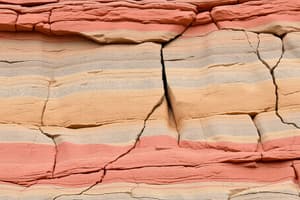Podcast
Questions and Answers
What dominates solid Earth materials at the surface?
What dominates solid Earth materials at the surface?
Sediments and sedimentary rocks
What are the two types of weathering?
What are the two types of weathering?
- Biological weathering
- Mechanical weathering
- Physical weathering (correct)
- Chemical weathering (correct)
What processes reflect clastic sedimentary rocks?
What processes reflect clastic sedimentary rocks?
Weathering, erosion, transportation, deposition, lithification
What is diagenesis?
What is diagenesis?
How is clast size categorized?
How is clast size categorized?
Match the following types of sedimentary rocks with their descriptions:
Match the following types of sedimentary rocks with their descriptions:
What does sorting refer to in sedimentary rocks?
What does sorting refer to in sedimentary rocks?
What factors determine the nature of soils in different regions?
What factors determine the nature of soils in different regions?
How do clastic and chemical sedimentary rocks differ?
How do clastic and chemical sedimentary rocks differ?
How does physical weathering differ from chemical weathering?
How does physical weathering differ from chemical weathering?
What conditions are required for the formation of evaporates?
What conditions are required for the formation of evaporates?
Describe how a clastic sedimentary rock is formed from its unweathered parent rock.
Describe how a clastic sedimentary rock is formed from its unweathered parent rock.
What happens during diagenesis?
What happens during diagenesis?
Flashcards are hidden until you start studying
Study Notes
Sediments and Sedimentary Rocks
- Sedimentary rocks dominate solid Earth materials at the surface, despite being rare in the overall crust.
Weathering
- Two types of weathering:
- Physical: mechanical breakage creates detritus.
- Chemical: decomposition through reaction with water (includes dissolution, hydrolysis, oxidation, hydration).
Clastic Sedimentary Rocks Formation
- Key processes include weathering, erosion, transportation, deposition, and lithification into solid rock.
Diagenesis
- Involves physical, chemical, and biological changes to sediment, including bioturbation, lithification, dissolution, mineral precipitation, and pressure solution.
Clast Size and Sorting
- Clast size ranges from coarse-grained (boulders, cobbles, pebbles) to fine-grained (silt, clay).
- Sorting indicates uniformity of grain size; well-sorted indicates uniformity, while poorly-sorted has a variety of sizes.
Clast Shape
- Reflects transport degree; well-rounded indicates prolonged transport, while angular suggests minimal movement.
Soil Composition
- Composed of rock and sediment modified by organic material and water, contributing to plant growth.
Soil Profile
- O Horizon: top layer rich in organic matter.
- A Horizon: mixed organic and mineral matter.
- E Horizon: leached transitional layer.
- B Horizon: organic-poor, mineral-rich layer.
- C Horizon: slightly altered parent material.
- Zones of leaching and accumulation persist throughout the profile.
Classification of Clastic Sedimentary Rocks
- Primarily classified based on grain size and shape.
Types of Sedimentary Rocks
- Breccia: angular clasts, minimal transport.
- Conglomerate: rounded clasts, indicates transport.
- Sandstone: sand-sized particles.
- Siltstone: silt-sized particles.
- Mudstone and shale: clay-sized particles.
Biochemical Sedimentary Rocks
- Formed from mineralized skeletons of organisms; examples include limestones and biogenic cherts.
Organic Sedimentary Rocks
- Composed of remains of plants that accumulate in boggy environments.
Chemical Sedimentary Rocks
- Result from precipitation; evaporates include halite and gypsum, often formed from evaporated seawater.
Stratification
- Refers to the layering of rocks.
Cross Bedding
- Indicates deposition along slopes and helps determine paleocurrent direction.
Sedimentary Rock Features
- Can contain fossils, ripple marks, and mud cracks, reflecting their depositional environment.
Sedimentary Environments
- Terrestrial: includes glacial, mountain streams, alluvial fans, sand dunes, lakes, and rivers.
- Marine: includes deltas, coastal beaches, shallow marine, and deep marine environments.
Environmental Changes
- Transgressions (rising sea levels) and regressions (falling sea levels) shift sediment belts.
Classes of Sediments
- Clastic, biochemical, organic, and chemical based on origin.
Weathering Differences
- Physical weathering breaks rocks into fragments; chemical weathering alters minerals through reactions.
Feldspar Weathering
- Common in igneous rocks, feldspars degrade into clay minerals like kaolinite during weathering.
Quick Weathering of Minerals
- Mafic silicates like olivine and pyroxene weather faster than felsic minerals such as quartz and feldspar.
Clastic Sedimentary Rock Formation
- Involves weathering, erosion, transportation, deposition, and lithification processes.
Soil Nature Determinants
- Influenced by climate, substrate composition, slope steepness, drainage, time, and vegetation.
Clastic vs. Chemical Sediments
- Clastic sediments transported as solid materials; chemical sediments arise from dissolved ions that crystallize upon evaporation.
Biochemical Rock Formation
- Produced from shells of organisms, leading to accumulation and lithification of skeletal debris on the seafloor.
Conditions for Evaporite Formation
- Require hot, dry climates and fluid with dissolved ions; examples include halite and gypsum.
Dolostone vs. Limestone
- Dolostone contains dolomite, has a sugary texture, and forms from the chemical alteration of limestone.
Cross Bed Formation
- Created by ripple and dune migration, with angled beds indicating current direction.
Turbidity Currents
- Formed by sediment disturbances on submarine slopes, producing graded bedding as sediments settle gradually.
Alluvial Fan vs. River vs. Deep-Marine Deposits
- Alluvial fans: coarse sediments at mountain bases.
- Rivers: sand and gravel in concave channels, fine sediments on floodplains.
- Deep-marine: fine particles predominating, forming shale and chalk/chert from plankton remains.
Diagenesis vs. Metamorphism
- Diagenesis includes chemical and physical changes during lithification, occurring at lower temperatures and pressures than metamorphism, which involves heat and pressure altering rocks.
Studying That Suits You
Use AI to generate personalized quizzes and flashcards to suit your learning preferences.




